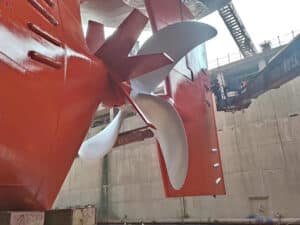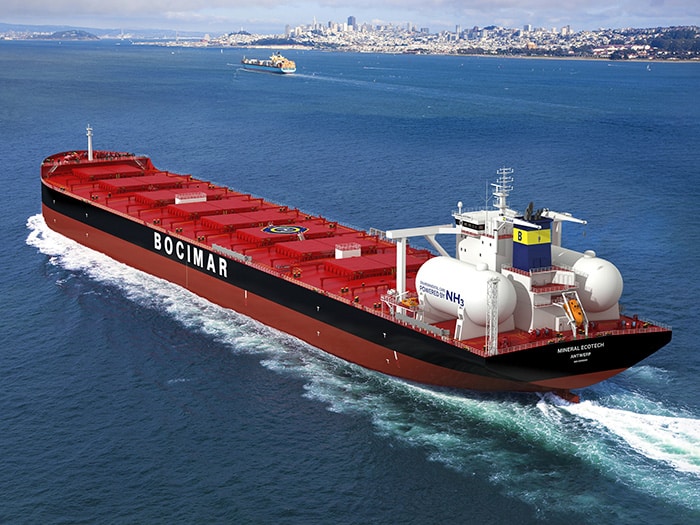
CMB.TECH and WinGD move ahead on ammonia-fueled bulkers
Written by Nick Blenkey
The aim is to have a 210,000 dwt bulker powered by an ammonia-fueled two-stroke in operation by 2025. [Image: CMB}
CMB.TECH, the clean tech division of Compagnie Maritime Belge (CMB), and CSSC group member WinGD have signed an agreement that will see WinGD X72DF‑A ammonia-fueled engines power a series of 210,000 dwt bulkers to be delivered through 2025 and 2026 to CMB Group member Bocimar. Other signatories to the agreement are CSSC Qingdao Beihai Shipbuilding (QBS), which will build the ammonia-fueled bulkers, and CSSC Engine Co (CSE), which will build the engines.
FIRST-AMMONIA FUELED BULKERS
The vessels will be the first ammonia-fueled bulkers to be built and the WinGD engine designs will be both the first of their size for ammonia and the first ammonia-fueled engines built in China.
WinGD’s X‑DF‑A engines operate using high-pressure fuel injection with a small portion of pilot fuel, and will have performance and fuel efficiency comparable to the company’s diesel-fueled X‑Engines. No aftertreatment is required for N2O emissions, while selective catalytic reduction is used to ensure Tier III NOx compliance in both ammonia and diesel modes.
Safe operation and maintenance of ammonia-fueled engines and vessels has been a key undertaking of the project to date. The hazard identification (HAZID) studies, followed by an Approval in Principle from Lloyd’s Register of the X‑DF‑A engine concept were pivotal to WinGD and CMB.TECH verifying that ammonia-fueled engines built, commissioned and operated to the approved design have equivalent safety to conventionally fuelled engines.
GREEN AMMONIA
“CMB.TECH sees green ammonia as one of the big solutions to decarbonise long-distance shipping and this order brings to fruition our active commitment to develop this pathway,” said CMB.TECH CEO Alexander Saverys. “The gathering of expertise under this agreement will ensure that our first ammonia-fueled vessels are built and powered in a safe and sustainable way, as well as helping to decarbonize our business and our customers’ logistics.”
The four-way agreement builds on the agreement to move ahead on the engine design that was reached by CMB.TECH and WinGD earlier this year,
“Having progressed the engine design and vessel integration concept rapidly with CMB.TECH over the past nine months, enlisting the mutual cooperation of the shipyard and engine builder is a critical next step,” said WinGD CEO Dominik Schneiter. “As well as safeguarding the successful entry into operation of these innovative engines, this collaboration will also accelerate the spread of ammonia capabilities across key stakeholder groups, placing the whole industry on surer footing as it explores a vital decarbonization pathway.”
“CMB.TECH’s decision to have its first ammonia-fueled vessels built by CSSC Qingdao Beihai Shipbuilding underscores the company’s faith in the quality and value of our work.” said QBS executive VP, Gu Kechao. “It also highlights growing acknowledgement of the wider Chinese capability in complex shipbuilding projects. Building among the first ammonia-fueled vessels in the world will place QBS in a strong position to support further customers with their maritime decarbonization projects.”
CSE chief engineer, Zhang Guangwei said: “Bringing a new engine design into commercial operation is aways the result of strong joint effort between engine and vessel designer, engine builder, shipyard and owner. CSE is honored to be the first engine builder in China to deliver ammonia-fueled engines to the maritime market, and to take an early role in what will become a significant market as ammonia fuel is used more widely in shipping.”




